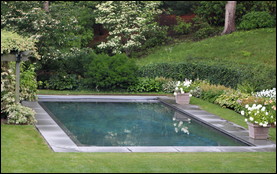 Having a water feature on the property can help naturally cool the air. |
The process of evaporation requires energy (or heat), as water molecules change from a liquid to a gaseous state. It takes much more energy to evaporate water than just to heat it. As evaporation takes place, energy is drawn from the surrounding air. So heat is used up and the air becomes cooler.
This cooling can also create a movement of the air (convection heat exchange), which one can feel as a breeze or wind. At ocean or lake side, these evaporation-induced air movements augment those produced by the simple thermal differentials of the air and water.
Homeowners can use these energy-exchange phenomena (evaporation, convection air currents and shade) to their maximum advantage by incorporating both plants and water into their garden designs. Think of the classic Spanish gardens, all of which had a fountain in the center — to cool the air, and the soul. No great classic garden or outstanding retreat is without some water. The tranquil or rippling surface, the ever-changing play of light and shadow as well as the sounds of running, bubbling water, have universal aesthetic appeal.
As evaporation takes place, the resulting energy (heat) loss makes a person, building or any object feel cooler. It explains the old Bedouin desert trick that keeps water cool. Water is kept stored in a canvas bag or porous clay jug. In both instances, seepage makes the outside surface stay wet. As the water evaporates from the surface, it draws hear from the water inside. The drinking water stays cool.
Traditionally hot courtyards always had fountains. In dry climates, an increase of humidity is especially welcome to people, plants and good furniture. Man-made lakes, pools and fountains can be used to advantage where no ocean or lake exists naturally. For maximum effects, they should be placed upwind, to both cool and humidify the largest area.
The amount of evaporation is directly related to the amount of surface area. A spray or fountain exposes more surface than still water. A similar cooling effect can be created by wetting or hosing down a patio, driveway, or roof. Roofs can have sprays or just running water over them for evaporative cooling. In very hot climates, a shallow water pool on the roof provides considerable energy savings. As the water cools at night, it becomes a cool blanket, which is ready when the next day heats up again. It evaporates during the day, drawing heat energy from the building.
In climates with hot sun but chilly nights, water roofs are warm and insulative, especially if the water has a chance to warm up late in the day. Sod roofs are also warm and insulative, but sometimes interiors tend to be damp.
All plants, especially trees, are very good at harnessing the water-evaporation energy exchange cycle. In addition to cooling by shade, trees also cool by evaporation of water from their leaves. The energy required for this evaporative process is taken out of the air as heat right in among the leaves. Then, as air temperature differentials develop between the interior of the tree and the air surrounding it, convection currents are set up. These draw air through the leaves and create the breeze that is always present under large trees on a warm day.
Credit: www.mothersgarden.net




























